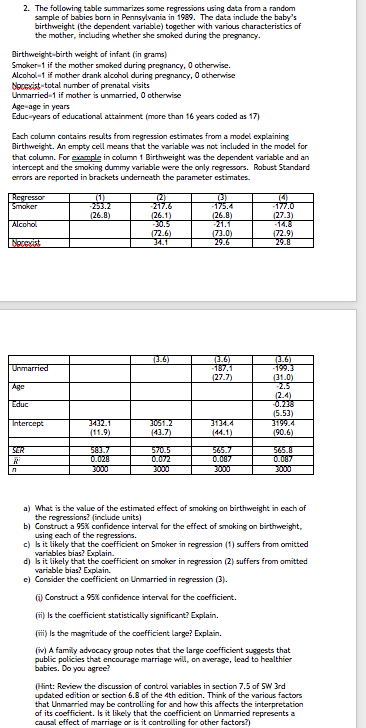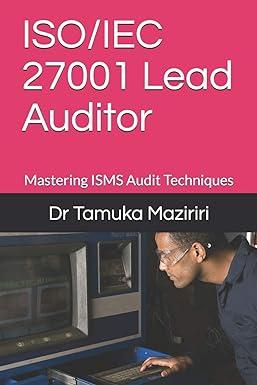
2. The following table summarizes some regressions using data from a random sample of babies born in Pennsylvania in 1989. The data include the baby's birthweight (the dependent variable) together with various characteristics of the mother, including whether she smoked during the pregnancy. Birthweight-birth weight of infant (in grams) Smoker-1 if the mother smoked during pregnancy, otherwise. Alcohol-1 if mother drank alcohol during pregnancy, otherwise Norevist-total number of prenatal visits Unmarried-1 if mother is unmarried, otherwise Age-age in years Educ years of educational attainment (more than 16 years coded as 17) Each column contains results from regression estimates from a model explaining Birthweight. An empty cell means that the variable was not included in the model for that column. For example in column 1 Birthweight was the dependent variable and an intercept and the smoking dummy variable were the only regressors. Robust Standard errors are reported in brackets underneath the parameter estimates. (0) 12) (3) Regressor Smoker 217.6 (26.1) (9 -177.0 (27.3) 126.8) Alcohol (26.8) 21.1 173.01 29.6 172.6) 172.9) Nevevist 32.1 (3.6) Unmarried 13.6) -187.1 (27.7) (356) -199.3 (31.0) Age 22 educ 12.4) -0.236 (5.53) Intercept 3051.2 143.7) 190.6 SER R (11.9) 5&3.7 0.020 570.5 0.072 3000 565.7 OLUN 3000 565.0 0.007 3000 a) What is the value of the estimated effect of smoking on birthweight in each of the regressions include units) b) Construct a 95% confidence interval for the effect of smoking on birthweight, using each of the regressions. c) bit likely that the coefficient on Smoker in regression (1) suffers from omitted variables bias? Explain. d) bit likely that the coefficient on smoker in regression (2) suffers from amitted variable bias? Explain. c) Consider the coefficient on Unmarried in regression (3). 6) Construct a 95% confidence interval for the coefficient. c) Is the coefficient statistically significant? Explain. (im) is the magnitude of the coefficient large? Explain. (iv) A family advocacy group notes that the large coefficient suggests that public policies that encourage marriage will, on average, lead to healthier babies. Do you agree? (Hint: Review the discussion of control variables in section 7.5 of SW 3rd updated edition or section 6.8 of the 4th edition. Think of the various factors that Unmarried may be controlling for and how this affects the interpretation of its coefficient. Is it likely that the coefficient on Unmarried represents a causal effect of marriage or is it controlling for other factors?) 2. The following table summarizes some regressions using data from a random sample of babies born in Pennsylvania in 1989. The data include the baby's birthweight (the dependent variable) together with various characteristics of the mother, including whether she smoked during the pregnancy. Birthweight-birth weight of infant (in grams) Smoker-1 if the mother smoked during pregnancy, otherwise. Alcohol-1 if mother drank alcohol during pregnancy, otherwise Norevist-total number of prenatal visits Unmarried-1 if mother is unmarried, otherwise Age-age in years Educ years of educational attainment (more than 16 years coded as 17) Each column contains results from regression estimates from a model explaining Birthweight. An empty cell means that the variable was not included in the model for that column. For example in column 1 Birthweight was the dependent variable and an intercept and the smoking dummy variable were the only regressors. Robust Standard errors are reported in brackets underneath the parameter estimates. (0) 12) (3) Regressor Smoker 217.6 (26.1) (9 -177.0 (27.3) 126.8) Alcohol (26.8) 21.1 173.01 29.6 172.6) 172.9) Nevevist 32.1 (3.6) Unmarried 13.6) -187.1 (27.7) (356) -199.3 (31.0) Age 22 educ 12.4) -0.236 (5.53) Intercept 3051.2 143.7) 190.6 SER R (11.9) 5&3.7 0.020 570.5 0.072 3000 565.7 OLUN 3000 565.0 0.007 3000 a) What is the value of the estimated effect of smoking on birthweight in each of the regressions include units) b) Construct a 95% confidence interval for the effect of smoking on birthweight, using each of the regressions. c) bit likely that the coefficient on Smoker in regression (1) suffers from omitted variables bias? Explain. d) bit likely that the coefficient on smoker in regression (2) suffers from amitted variable bias? Explain. c) Consider the coefficient on Unmarried in regression (3). 6) Construct a 95% confidence interval for the coefficient. c) Is the coefficient statistically significant? Explain. (im) is the magnitude of the coefficient large? Explain. (iv) A family advocacy group notes that the large coefficient suggests that public policies that encourage marriage will, on average, lead to healthier babies. Do you agree? (Hint: Review the discussion of control variables in section 7.5 of SW 3rd updated edition or section 6.8 of the 4th edition. Think of the various factors that Unmarried may be controlling for and how this affects the interpretation of its coefficient. Is it likely that the coefficient on Unmarried represents a causal effect of marriage or is it controlling for other factors?)







